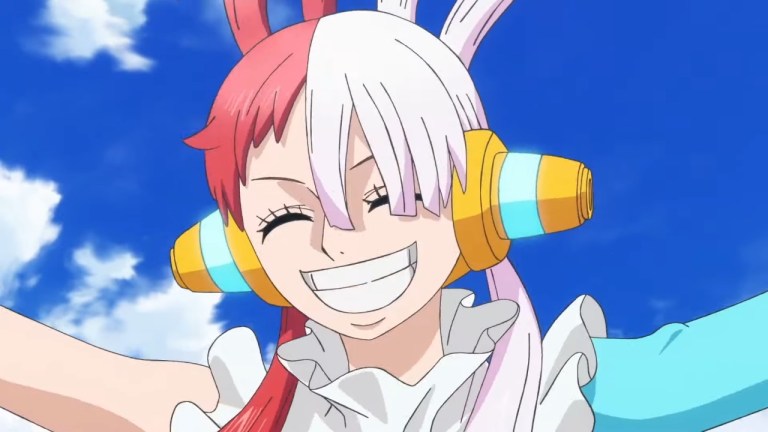How One Piece Film: Red Breaks The One Piece Rules
Gorō Taniguchi, Shinji Shimizu, and Hiroaki Shibata get candid on the newest One Piece feature film that’s breaking box office records in Japan.

Eiichiro Oda’s One Piece has been a staple of the manga and anime industry for nearly 25 years. Now, more than 1000 episodes later, it appears that Oda’s prolific adventure story is finally preparing for its final act. The One Piece feature films have become exciting ways to push the anime in unexpected directions, but the recent One Piece Film: Red, the franchise’s 15th film, is easily the most unique movie to date. One Piece Film: Red focuses on Red-Haired Shanks and Uta, a revered musician, who just so happens to be his daughter. Uta’s musical performances border on spectacles, but her divine voice makes her a target for nefarious figures.
One Piece Film: Red has broken box office records as the most successful One Piece film to date and the celebrated movie’s English dub is set to hit theaters on Nov. 4th in North America. The film’s director, Gorō Taniguchi, executive producer Shinji Shimizu, and producer for the anime series Hiroaki Shibata spoke with Den of Geek via translator about this unusual addition to the One Piece canon, how it became a “concert film,” Eiichiro Oda’s involvement in the movie, and what they think of Netflix’s upcoming live-action One Piece series.
DEN OF GEEK: Taniguchi-san, you were previously asked several times to direct a One Piece movie, but always turned down the opportunities. What was it about One Piece Film: Red that changed your mind?
GORŌ TANIGUCHI: Well, I’ve actually been offered the role of director three times in the past, which is very humbling and flattering—it’s kind of a big deal. And there are only so many times that you can turn someone down! But really, for myself, I was really questioning whether I was the right choice to direct this. I asked producers if they could ask Oda sensei if that’s really what he wants and if I was truly the right fit. Evidently, they got an immediate “yes” from Oda sensei, so that’s when I started to feel good about taking on this role and directing this film.
Taniguchi-san, I’ve read that your goal with this movie was to “destroy” the conventions of One Piece and create something new and special. Can you elaborate on that mission statement?
GT: Well, One Piece in its current state—the TV series and franchise—has been ongoing for 23 years. What that means is that there are certain rules of specific productions, business models, and even the technical aspects in the pipeline that were set in motion 23 years ago, but may not apply anymore or are now obsolete in our current day. When I joined the technical side, I could definitely see a lot of old systems that were in place for the production pipeline. That was one of the challenges that I wanted to take on and use more current gen mindsets with how we approach the production and development of this project.
One Piece Film: Red has lots of traditional One Piece action, but in many ways it almost feels like a concert film. How did that idea come together and why was Ado the right singing voice for Uta?
SHINJI SHIMIZU: Early on in the project’s development I thought about putting the spotlight on music and making that a central motif in the film. When we were still in early meetings about the screenplay and where to take the film, Oda-san warned me, “Are you sure you want to do a music-centric film? That’s a lot of work. Is everything going to be okay?” And I said, “It’s going to be fine!” Of course, that was more of the producer in me that was calculating away because Oda-san is a big fan of music himself, so I thought that he’d work extra hard on this project if we made it themed around music. I think that was Oda-san’s way of asking me if I was ready to put in the necessary amount of work to pull this off. I didn’t think about it too hard, but I of course said “yes.”
GT: We did have a model on how to make a movie using music, so to give Shimizu-san some credit, he didn’t just make these statements without any plans. He knew that the team would be able to take on the challenge and were up for it. So there was a degree of trust there between the production team and Shimizu-san when he had this conversation with Oda-san.
Were the songs written first and then the story afterwards to compliment them, or was it the other way around?
SS: Screenplay first. Story.
One Piece movies typically feature older males as their main characters. Was the pivot towards Uta an intentional choice to mix things up and help the film appeal to a younger crowd?
HIROAKI SHIBATA: This is a comment from Oda sensei himself, but he jokingly said one time that he’s tired of drawing old men! There might be a grain of truth to that, but he really wanted to create a leading role here for a female that had great significance. As the movie started to near completion, that’s when I first realized as a producer what Oda sensei was trying to do as I saw it all come together.
Oda sensei has been writing the manga for 25 years now and every time that he writes a new chapter I definitely think that there’s a commentary that he wants to make with it. There’s always a certain message that needs to stay fresh. Whatever that message is has constantly shifted throughout the years. In the case of this film, I’m sure that on some level he thought the best way to deliver this story was with a character like Uta and through this screenplay. There was a lot of trust with the director and the talent, but what Oda sensei was trying to do took me a minute to fully comprehend, but in the end it’s the strongest version of One Piece that he can deliver to the current audience, but also make sure that it’s socially relevant in our current climate.
Shanks has become one of the most popular One Piece characters and fans have wanted to see him in a movie for a long time. Was it exciting to get to explore such a big showcase for not only his character, but all of the Red-Haired Pirates?
SS: I personally really like Shanks and I always asked in the past films if we could put Shanks in the movie and every time Oda sensei would tell me that it wasn’t time yet and that Shanks can’t be used in that way. With where the arc is currently in the manga where it’s dealing with the four greatest major pirates in the world, I thought that it was maybe time and so I asked Oda sensei once again, it went through all of the editors, and he finally gave us the greenlight. So the timing was just perfect to be able to bring Shanks onto the big screen.
This movie truly looks beautiful and there’s some really creative uses of 3D CGI in Uta’s performances. How did you make these decisions and figure out the movie’s look?
HS: This is a musically-charged film, but that’s not to say that the story isn’t also important. It’s a fine balance between character, emotion, energy, and performance and what’s the best way to translate that onto the screen. That’s where Toei has a background that could help us. In terms of the 3D, dancing, and singing, there’s a show called PreCure [Pretty Cure] and for about ten years they’ve slowly been building up this arsenal of techniques and knowledge. So when it came time to finalize the music and performances that we wanted, it came down to us mo-capping dancers to get the proper choreography. Of course, we couldn’t use the 3D as is given the look and feel of One Piece, so director Taniguchi-san and AD assistant director, both worked really hard to then take those mo-cap assets and other 3D components to turn it into more of this hybrid experience.
Taniguchi-san, you directed the 1998 One Piece OVA, Defeat Him! The Pirate Ganzack and are technically the first person who’s responsible for animating Luffy. Can you talk about that original opportunity and what it was like to return to the character and this world nearly 25 years later?
GT: Interestingly, the 1998 OVA was my first time directing a project. When I finally came onboard to One Piece Film: Red as a director, it almost felt like we were coming full circle in a strange way and that I was returning to my roots and origins. I knew that a lot of the same people and team members would be working on the movie together and part of me was excited and nostalgic to get this reunion, but part of me was also anxious in terms of what time has possibly done to our dynamic and what else has changed over time. It was a mix of emotions for me, but once we got into the production it became clear that there was a lot more that hadn’t changed—in a good way—and we could immediately meld as a team and get back into it.
Do you think that this is the last that audiences have seen of Uta or might she return in the future?
HS: Honestly, that’s a character that Oda sensei invented and developed himself so whether or not she’ll return is something that even I don’t know from just watching the film alone. What I can say is that during the end credits everyone is singing Uta’s songs and there’s a certain energy. My belief is that therein lies the answer to that question.
One Piece Film: Red has the biggest box office success for any One Piece film. Does that make you interested at all to return to direct a future movie?
GT: Firstly, I’m very interested and invested in the worlds and stories that Oda sensei creates. However, the final decision of whether or not I’ll come back as a director is really up to the fans and the producers. So, I have my own thoughts, but the final decision rests with them. What I can say is that’s how I see myself getting back involved. It’s up the producers to ask if the opportunity should ever present itself.
With a live-action One Piece series currently in production for Netflix, have any of you been able to see any of their work and are you excited to see how this animated world gets translated into real-life?
GT: I look forward to it. I’m certainly curious how it will translate, but I think, if anything, that will light our fire again so we can remind everyone just what anime can do and accomplish.
One Piece Film: Red is currently playing in limited theaters.
